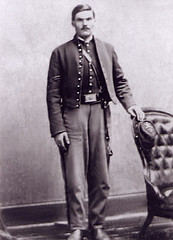Notable Rhode Island artillerymen
22 January 2008
Just a quick post this week – I’ve too many irons in the fire. Blog neglect aside, though, January has been a good month for incoming treasures and catching up with biographies on AotW.

Corporal James A Barber (M. Frazel)
One in particular came out of a post I found on Granite in my Blood just before Christmas in which Midge Frazel transcribed a relative’s narrative about the Barber Family. Included was her great-grandfather James Albert Barber, who was in Battery G, First Rhode Island Light Artillery…
Snapshots
15 January 2008

While chasing one of my boys, Lieutenant Colonel Samuel W. Owen, 3rd Pennsylvania Cavalry, I came on a photograph of him in an unusual setting. It made me think about how few casual or frivolous pictures–snapshots–I’ve can remember seeing among (probably) thousands of American Civil War-era images.
On reflection, this isn’t surprising. Due to the technical demands of wet-plate photography during the War, I’d expect most photographs to have a serious purpose. The long exposures and difficulty in preparing and developing photographs in the field probably made it less likely that photographers would risk wasting film on a moving subject or mundane scene.
Perhaps as a result, most surviving photographs are stiffly posed, and live subjects seem terribly aware of the camera. For fun, today, I’ve found a few with quite a different feel …
The very image of a soldier: A. V. Colburn
5 January 2008


Lieut.-Col. A.V. Colburn, Warrenton, Va, November 1862 (studio of M. Brady, Library of Congress)
A brand new Lieutenant at First Bull Run in July 1861, George A Custer later recalled with envy a gallant charge by a squadron of the 1st US Cavalry under Capt Colburn early in the battle. The charge may not have actually happened, which is sad for the romantics like Custer, particularly as the first major battle of the War was Colburn’s last in hands-on field command.
Albert V. Colburn is best known now as Assistant Adjutant General (AAG) to George McClellan during the General’s terms in command of the Army of the Potomac. Students of that army will come upon Colburn’s name frequently–on orders, reports and letters–as he so often served as the voice of the General Commanding.
Let me offer just a little more about the man behind the signature …
